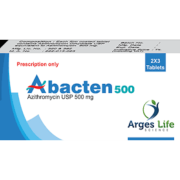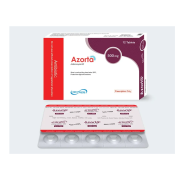Arizith Tablet
Azithromycin Dihydrate
500 mg
Centeon Pharma Ltd.
Unit Price: ৳ 45.00 (2 x 6: ৳ 540.00)
Strip Price: ৳ 270.00
Indications
Arizith is indicated for infections (caused by susceptible organisms) in lower respiratory tract infections including bronchitis and pneumonia, in upper respiratory tract infections including sinusitis and pharyngitis/tonsillitis, in otitis media, and in skin and soft tissue infections. In sexually transmitted diseases in men and women, Arizith is indicated in the treatment of non-gonococcal urethritis and cervicitis due to Chlamydia trachomatis.
Pharmacology
Azithromycin is acid-stable and can therefore be taken orally with no need of protection from gastric acids. It is readily absorbed; its absorption is greater on an empty stomach. Time to peak concentration in adults is 2.1 to 3.2 hours for oral dosage forms. Due to the high concentration in phagocytes, azithromycin is actively transported to the site of infection. During active phagocytosis, large concentrations of azithromycin are released. The concentration of azithromycin in the tissues can be over 50 times higher than in plasma. This is due to ion trapping and the high lipid solubility.
Azithromycin’s half-life allows a large single dose to be administered and yet maintain bacteriostatic levels in the infected tissue for several days. Following a single 500 mg dose, plasma concentrations of azithromycin declined in a polyphasic pattern with a mean apparent plasma clearance of 630 mL/min and a terminal elimination half life of 68 hours. The prolonged terminal half-life is thought to be due to extensive uptake and subsequent release of drug from tissues. Biliary excretion of azithromycin, predominantly unchanged, is a major route of elimination. Over the course of a week, approximately 6% of the administered dose appears as unchanged drug in urine.
Microbiology: Azithromycin acts by binding to the 50S ribosomal subunit of susceptible microorganisms and, thus, interfering with microbial protein synthesis. Nucleic acid synthesis is not affected. Azithromycin has been shown to be active against most isolates of the following microorganisms, both in vitro and in clinical infections:
- Aerobic and facultative gram-positive microorganisms: Staphylococcus aureus, Streptococcus agalactiae, Streptococcus pneumoniae, Streptococcus pyogenes
- Aerobic and facultative gram-negative microorganisms: Haemophilus ducreyi, Haemophilus influenzae, Moraxella catarrhalis, Neisseria gonorrhoeae
- Other microorganisms: Chlamydia pneumoniae, Chlamydia trachomatis , Mycoplasma pneumoniae , Betalactamase production should have no effect on azithromycin activity.
- Aerobic and facultative gram-positive microorganisms: Streptococci (Groups C,F,G), Viridans group streptococci
- Aerobic and facultative gram-negative microorganisms: Bordetella pertussis, Legionella pneumophila
- Anaerobic microorganisms: Peptostreptococcus species, Prevotella bivia
Dosage
Oral–
Adult: 500 mg once daily orally for 3 days or 500 mg once on day 1, then 250 mg once on days 2-5 for 4 days. For sexually transmitted diseases caused by Chlamydia trachomatis in adults, the dose is 1 gm given as a single dose or 500 mg once on day 1, followed by 250 mg once daily for next 2 days may also be given.
Children:
- 10 mg/kg body weight once daily for 3 days for child over 6 months
- 200 mg (1 teaspoonful) for 3 days if body weight is 15-25 kg
- 300 mg (1½ teaspoonfuls) for 3 days if body weight is 26-35 kg; 400 mg (2 teaspoonfuls) for 3 days if body weight is 36-45 kg.
- In typhoid fever, 500 mg (2½ teaspoonfuls) once daily for 7-10 days is given.
Azithromycin Injection (For IV Infusion only): The recommended dose of Azithromycin for injection for the treatment of adult patients with community-acquired pneumonia due to the indicated organisms is:
- 500 mg as a single daily dose by the intravenous route for at least two days. Intravenous therapy should be followed by Azithromycin by the oral route at a single, daily dose of 500 mg, administered as two 250-mg tablets to complete a 7 to 10-day course of therapy. The timing of the switch to oral therapy should be done at the discretion of the physician and in accordance with clinical response.
- The recommended dose of Azithromycin for the treatment of adult patients with pelvic inflammatory disease due to the indicated organisms is: 500 mg as a single daily dose by the intravenous route for one or two days. Intravenous therapy should be followed by Azithromycin by the oral route at a single, daily dose of 250 mg to complete a 7-day course of therapy. The timing of the switch to oral therapy should be done at the discretion of the physician and in accordance with clinical response. If anaerobic microorganisms are suspected of contributing to the infection, an antimicrobial agent with anaerobic activity should be administered in combination with Azithromycin.
- Safety and effectiveness of azithromycin for injection in children or adolescents under 16 years have not been established.
Administration
Reconstitution procedure of suspension-
- Step 01: Shake the bottle well to loosen the powder.
- Step 02: Add boiled and cooled water up to the water mark of the bottle label.
- Step 03: Shake until powder is completely mixed with water.
Azithromycin should be taken at least 1 hour before or 2 hours after meal.
Interaction
Antacid: In patients receiving azithromycin and antacids, azithromycin should be taken at least 1 hour before or 2 hours after the antacid. Carbamazepine: In a pharmacokinetic interaction study in healthy volunteers, no significant effect was observed on the plasma levels of carbamazepine or its active metabolite.
Cyclosporin: Some of the related macrolide antibiotics interfere with the metabolism of cyclosporin. In the absence of conclusive data from pharmacokinetic studies or clinical data investigating potential interactions between azithromycin and cyclosporine, caution should be exercised before co-administration of these two drugs. If coadministrations is necessary, cyclosporin levels should be monitored and the dose adjusted accordingly.
Digoxin: Some of the macrolide antibiotics have been reported to impair the metabolism of digoxin (in the gut) in some patients. Therefore, in patients receiving concomitant azithromycin and digoxin the possibility of raised digoxin levels should be borne in mind and digoxin levels monitored.
Ergot derivatives: Because of the theoretical possibility of ergotism, azithromycin and ergot derivatives should not be co-administered.
Methylprednisolone: In a pharmacokinetic interaction study in healthy volunteers, azithromycin had no significant effect on the pharmacokinetics of methylprednisolone.
Theophylline: There is no evidence of any pharmacokinetic interaction when azithromycin and theophylline are co-administered to healthy volunteers. In general, however, theophylline levels should be monitored.
Warfarin: In a pharmacodynamic interaction study, azithromycin did not alter the anticoagulant effect of a single 15 mg dose of warfarin administered to healthy volunteers. Arizith and warfarin may be co-administered, but monitoring of the prothrombin time should be continued as routinely performed.
Terfenadine: Arizith did not affect the pharmacokinetics of terfenadine administered at the recommended dose of 60 mg every 12 hours. Addition of azithromycin did not result in any significant changes in cardiac repolarisation (QTc interval) measured during the steady state dosing of terfenadine.
Contraindications
Azithromycin Dihydrate is contraindicated in patients hypersensitive to Azithromycin or any other macrolide antibiotic. Co-administration of ergot derivatives and Azithromycin is contraindicated. Azithromycin is contraindicated in patients with hepatic diseases.
Side Effects
Arizith is well tolerated with a low incidence of side-effects. Most side-effects observed were mild to moderate in severity. The majority of side-effects were gastrointestinal in origin with nauseas, abdominal discomfort (pain/cramps), vomiting, flatulence, diarrhoea and loose stools being occasionally observed. Allergic reactions such as rash or photosensitivity have occurred and there have also been rare reports of serious hypersensitivity reactions. Reversible elevations in liver transaminases have been seen with a frequency similar to the comparative macrolides and penicillins used in clinical trials. Rarely, cases of cholestatic jaundice have been observed. Transient mild reductions in neutrofil counts have occasionally been observed in clinical trials, although a causal relationship to azithromycin has not been established. Hearing impairment: In investigational studies where higher doses were used for prolonged periods of time, reversible hearing impairment was seen in some patients.
Pregnancy & Lactation
Pregnancy Category of Azithromycin Dihydrate is B. Animal reproduction studies have demonstrated that Azithromycin has no evidence of harm to the fetus. There are no adequate and well controlled studies in pregnant women. Since animal reproduction studies are not always predictive of human response, Azithromycin should be used during pregnancy only if adequate alternatives are not available. It is not known whether Azithromycin is secreted in breast milk. So, caution should be exercised when Azithromycin is administered to nursing women.
Precautions & Warnings
As with erythromycin and other macrolides, rare serious allergic reactions, including angioneurotic oedema and anaphylaxis, has been reported. Some of these reactions with azithromycin have resulted in recurrent symptoms and required a long period of observation and treatment.
Use in Special Populations
Use in renal impairment: No dose adjustment is needed in patients with mild renal impairment (creatinine clearance >40 ml/min), but there are no data regarding azithromycin in patients with more severe renal impairment, thus caution should be exercised in using azithromycin in these patients.
Use in hepatic impairment: As the liver is the principal route of excretion of azithromycin, it should not be used in patients with hepatic disease.
Effects on ability to drive and use machines: There is no evidence to suggest that azithromycin may have an effect on a patient’s ability to drive or operate machinery.
Overdose Effects
There is no data on overdosage with Arizith. Typical symptoms of overdosage with macrolide antibiotics include hearing loss, severe nausea, vomiting and diarrhoea. Gastric lavage and general supportive measures are indicated.
Storage Conditions
Keep in a dry place away from light and heat. Keep out of the reach of children.
Chemical Structure
| Molecular Formula : | C38H72N2O12 |
| Chemical Structure : |
Common Questions about Arizith 500 mg Tablet
What is Arizith 500 mg Tablet?
Arizith 500 mg Tablet performs its action by preventing the synthesis of essential proteins required by bacteria to carry out vital functions.
What are the uses of Arizith 500 mg Tablet?
Arizith 500 mg Tablet is used for the treatment and prevention of community-acquired pneumonia, pharyngitis/tonsillitis, and skin and soft tissue infections.
What are the Side Effects of Arizith 500 mg Tablet?
Side effects include diarrhea, dry or scaly skin, abdominal pain, difficult or painful urination, vomiting, fever, acid or sour stomach, aggression or anger, excessive air or gas in the stomach, and heartburn.
What are the instructions for storage and disposal Arizith 500 mg Tablet?
Arizith 500 mg Tablet should be kept in a cool dry place and its original packaging. Make sure this medication remains unreachable to children and pets. The patient should consult a doctor for its further uses.
Can the use of Arizith 500 mg Tablet cause diarrhea?
Yes, the use of Arizith 500 mg Tablet can cause diarrhea. It is an antibiotic that kills harmful bacteria. However, it also affects the helpful bacteria in your stomach or intestine and causes diarrhea. If you are experiencing severe diarrhea, consult your doctor immediately.
Is Arizith 500 mg Tablet safe?
Arizith 500 mg Tablet is safe if used at prescribed doses as advised by your doctor.
Is Arizith 500 mg Tablet an antibiotic?
Yes, Arizith 500 mg Tablet is an antibiotic that belongs to a class of antibiotics known as macrolides.
What if I don’t get better even after taking Arizith 500 mg Tablet?
You should inform your doctor if you do not notice any improvement in your symptoms after 3 days of taking Arizith 500 mg Tablet and if your symptoms get worse.
Quick Tips
- Do not skip any doses of Arizith 500 mg Tablet and finish the full course of treatment even if you feel better. Stopping it early may make the infection to come back and harder to treat.
- Take Arizith 500 mg Tablet 1 hour before or two hours after food.
- Do not take antacids 2 hours before or after taking Arizith 500 mg Tablet.
- Diarrhea may occur as a side effect but should stop when your course is complete. Inform your doctor if it doesn’t stop or if you find blood in your stools.
- Stop taking Arizith 500 mg Tablet and inform your doctor immediately if you develop an itchy rash, swelling of the face, throat or tongue or breathing difficulties while taking it.
* রেজিস্টার্ড চিকিৎসকের পরামর্শ মোতাবেক ঔষধ সেবন করুন‘


